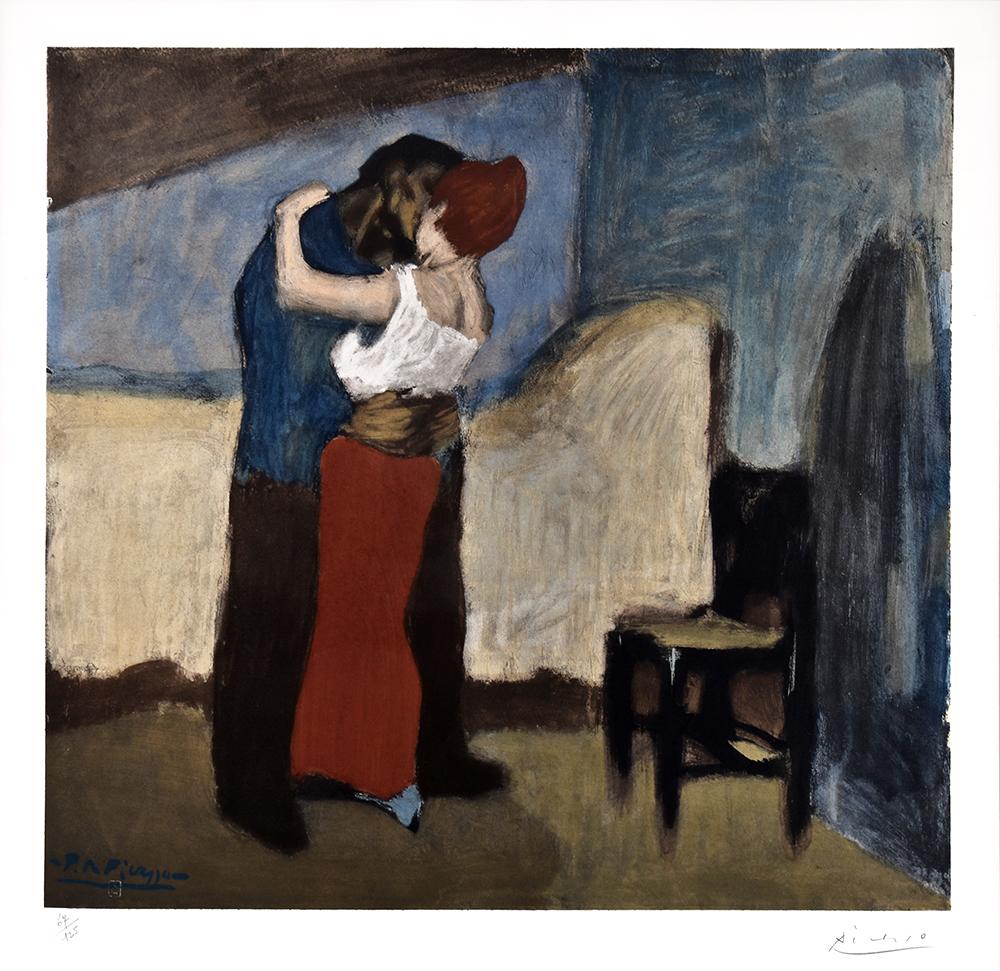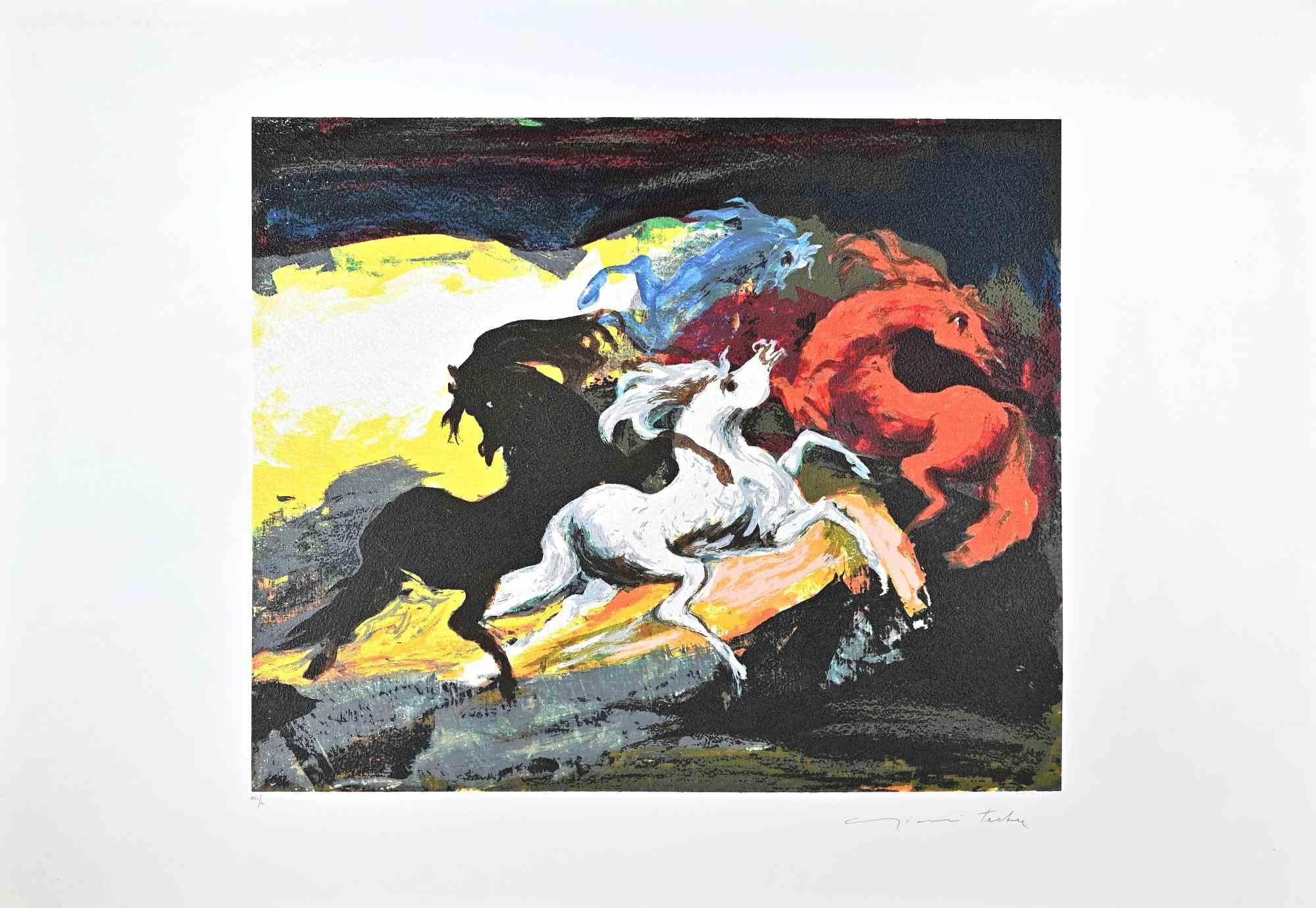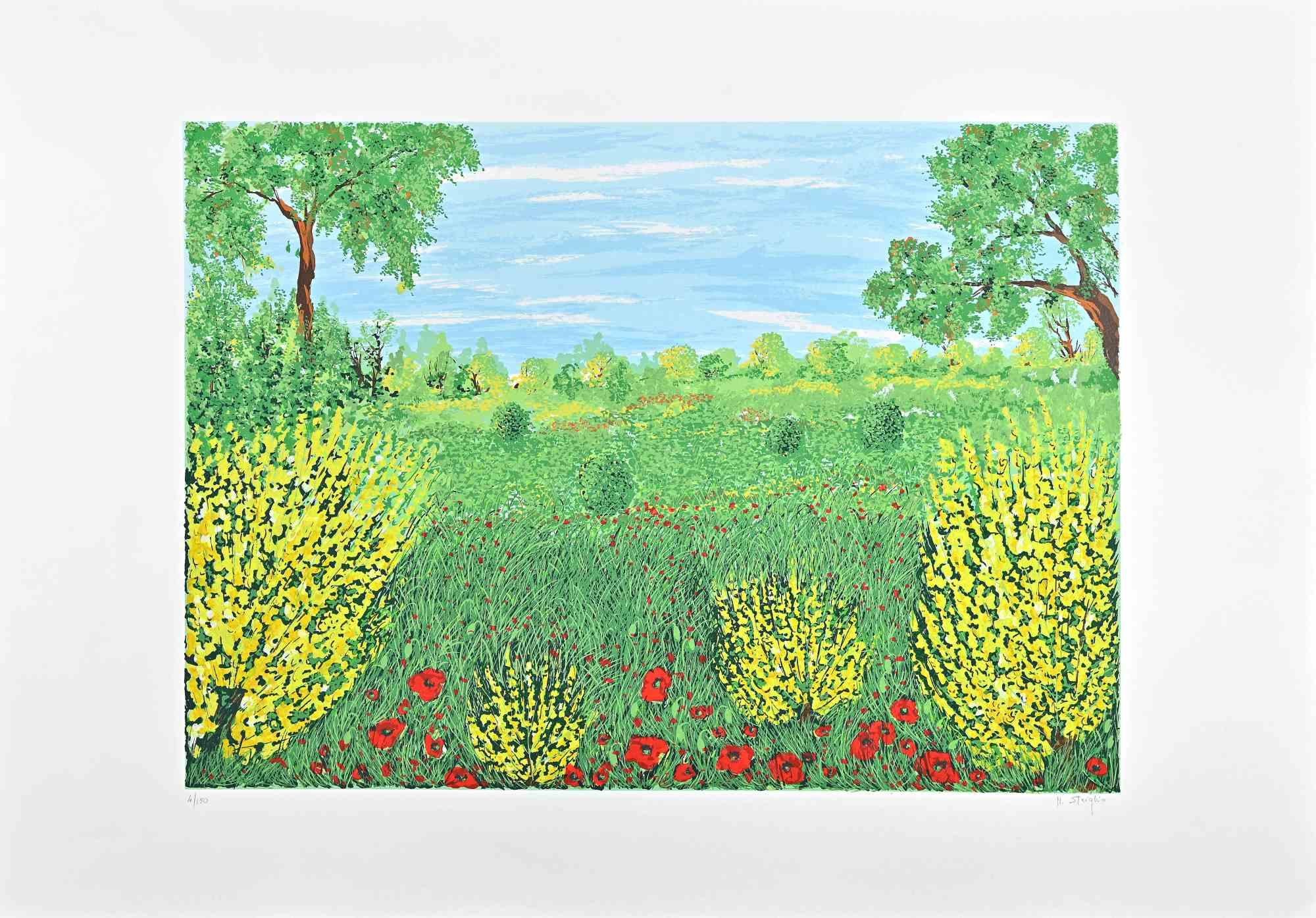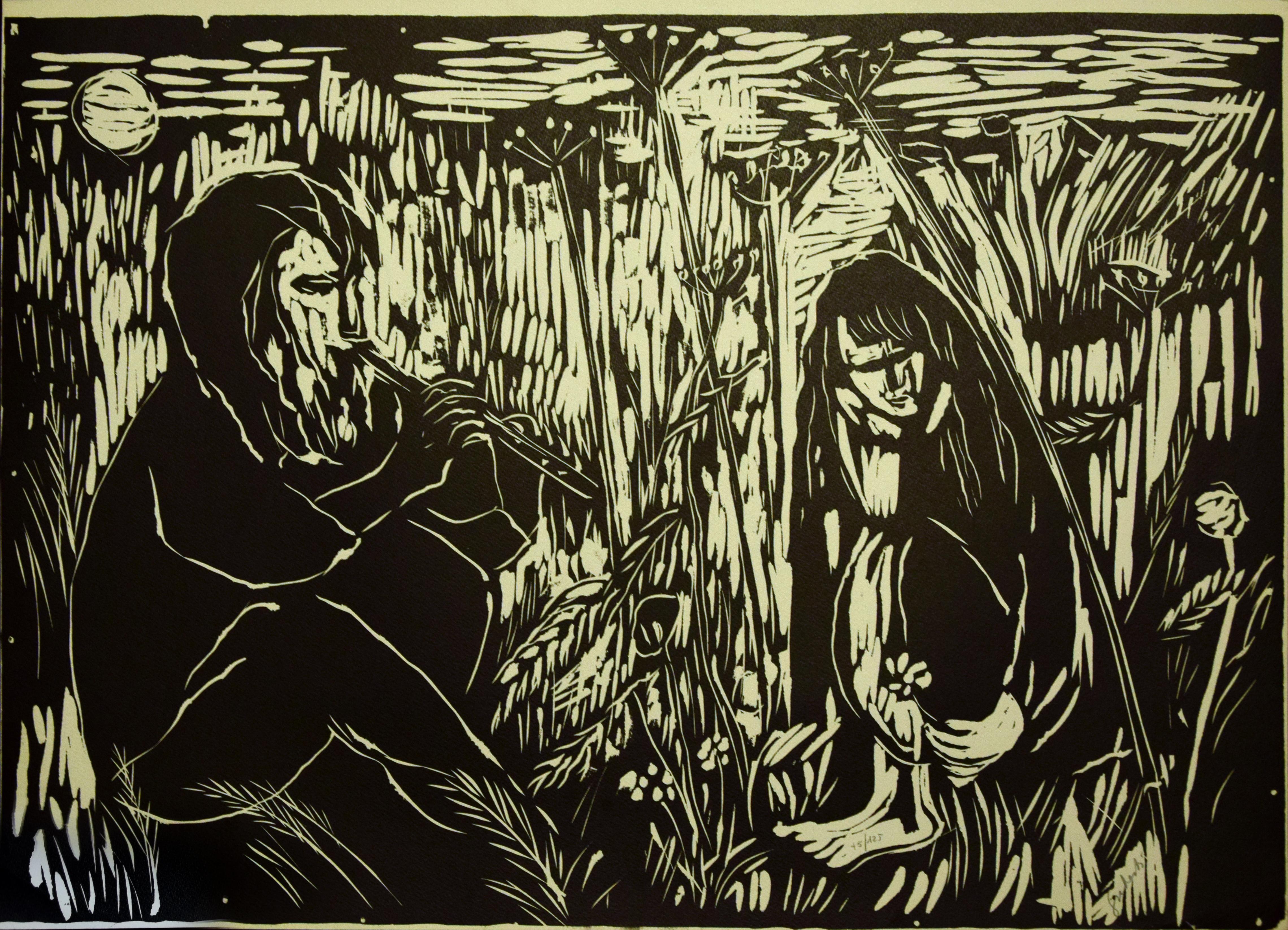Items Similar to Ramayana
Want more images or videos?
Request additional images or videos from the seller
Ting Shao KuangRamayana1995
1995
About the Item
This artwork titled "Ramayana" 1995, is an original color serigraph on wove paper by noted Chinese artist Ting Shao Kuang, b.1939. It is unsigned as issue. There is a hand signed and numbered edition of the same image. The artwork (image) size is 26 x 26 inches, the sheet is 31.5 x 32 inches. This artwork is a trial (test) proof. The printer will print the same subject in different colors combination for the artist to select the one he want for producing the final signed and numbered edition. Some of these trial proof are unique as only one copy was printed with these particular colors. You can see on the right margin all the colors that where selected by the printer and artist to create this artwork. It is in excellent condition.
About the artist:
Ting Shao Kuang, a prominent contemporary Chinese painter in America, has produced works characterized by a combination of traditional Chinese painting techniques and the more expressive Western art forms. He has created a unique style that does not belong exclusively to the East or the West, but to the world.
Ting Shao Kuang was born in Chenggu, a village located in the Northern province of Shanxi, China in 1939. The year Ting was born, this area, which once was the center of an advanced civilization, was reeling from the ravages of the Sino-Japanese war. But as the war progressed, Ting's father, a Kuomintang official in Beijing, helped rally the Nationalist forces, and the Japanese Imperial Army was eventually defeated. Mao Zedong's People's Liberation Army took over the government of China only two years after the war, forcing Ting's parents to flee to Taiwan. They left Ting in Beijing with his grandparents who were suffering immensely from the poverty that was inflicted upon them by the Government.
In order to survive his loneliness and alienation, Ting turned to painting for solace. By age 11, he was painting every day, using cooking oil as a medium for his pigment. Despite his lack of adequate supplies, he evidenced such remarkable talent that, in 1954, he was given the opportunity to attend the prestigious high school affiliated with the Central Academy of Fine Arts in Beijing.
In 1957, Ting was accepted at Beijing's Central Academy of Arts and Crafts. Although he was taught "Socialist Realism" in his classes, it was during this time that he discovered the works of Picasso, Matisse and Modigliani. The paintings of these artists inspired him to experiment with new themes and techniques. The summer before he began his senior year, Ting went to the Yellow River to paint the birthplace ofChinese civilization. However, when he arrived he found such misery and poverty, due to the disastrous Great Leap Forward, that he returned to Beijing. Because of the impact his trip had on him, he committed himself to painting only the beautiful side of life.
After graduating in 1962 with highest honors, Ting was signed to teach at the Yunnan Art Institute in Kunming. Here he painted during the night in an abstract style that was considered unacceptable by the government. This forced him to burn his paintings each morning to avoid being caught by the authorities. Although the people in Kunming had more freedom than Ting had ever known, his modernistic views still managed to come to the attention of the authorities. As a result, in 1967, he was suspended from his job and, when rumors of his impending imprisonment reached Kunming, he escaped into northern China. He found sanctuary in the Buddhist monasteries of Gansu where he studied the ancient sculptures they contained. Later he went to Dunhuang , an ancient caravan stop of the Silk Route from 4th to the 13th century, where he studied the paintings preserved on the walls and ceilings of over four hundred caves.
In 1968, Ting felt it was safe to return to Kunming even though it was mandatory to attend political meetings and it was still impossible for him to teach. By that time, however, there were four other artists there who shared his artistic views. After Mao died in 1976 and art classes finally resumed, the friendship that began in secret slowly began to surface. In 1979, these artists formed the Yunnan Shen She Art Association and, three years later, they exhibited at the First International Art Show in Hong Kong. In the same year, Ting was commissioned to paint a mural in the Great Hall of the People, which was an extraordinary honor for any artist, especially one who was considered to be an outsider, philosophically.
Living in the United States since 1980, Ting Shao Kuang has had more than one hundred personal exhibitions in America, Japan, Canada, Greece, Hong Kong and Taiwan, and has become a force in the international art world. Ting's purposeful marriage of ancient art customs, masterful brush strokes, and calligraphic lines, mixed with the starkness and beauty of modernism, have made his works some of the most recognizable in the world. He is considered a world-renowned leader of the Yunnan School by the American art critic Douglas Finly. Japanese art critic Murobushi thinks him an exceptionally authentic Chinese artist, and French art critic Andre Parinaud once commented that "His art has a timeless exuberance, and its exultation of love has turned him into a 20th century Giotto"
- Creator:Ting Shao Kuang (1933, Chinese)
- Creation Year:1995
- Dimensions:Height: 31.5 in (80.01 cm)Width: 32 in (81.28 cm)Depth: 0.01 in (0.26 mm)
- Medium:
- Movement & Style:
- Period:
- Condition:
- Gallery Location:San Francisco, CA
- Reference Number:
Ting Shao Kuang was born in 1939, in Chenggu, a small village located in the Northern province of Shanxi, China. His earliest childhood was marked by the horrors of the Sino-Japanese war that destroyed his land and left him abandoned after the evacuation of his parents to Taiwan. He found his consolation and escape in painting and by the age of 11, he painted on a daily basis, using the cooking oil as a medium for the pigment. Even besides his limited supplies, Ting Shao Kuang managed to use his extraordinary talent and got the opportunity to attend a prestigious high school which was connected with the Beijing’s Central Academy of Arts and Crafts where he later gained his further education. His painting lessons were based on rules of Social Realism without freedom of expression and with the strict prohibition of any foreign influences. After graduation in 1962, Kuang obtained a position to teach at the Yunnan Art Institute in Kunming. Painting the unacceptable abstract paintings during the night, he would destroy every piece of them in the morning, fearing of the arrestment of the authorities of the country. Still, Ting Shao Kuang’s progressive and modern vision did not fail to attract the attention and he was suspended from his work and escaped to northern China, finding the refuge in Buddhist monasteries in Gansu where he studied ancient sculpture and cave paintings on the old Silk Route which had been preserved for centuries.
Using the distinctive technique, Ting Shao Kuang’s work combines traditional Chinese influences with the Western art forms. Always turning to the female characters as his favorite subjects, their sophisticated shapes have been created from the artist’s deepest feelings and literature that inspired him. After the death of Mao, Kuang and his colleagues founded the famous Yunnan Shen She Art Association and the artist got his first big commission to paint a mural in the Great Hall of the People. Although the achieved the success and recognition in his country, Ting Shao Kuang decided to try the luck in the United States. Living in the Los Angeles since 1980, his work has been exhibited in numerous shows worldwide.
About the Seller
5.0
Platinum Seller
These expertly vetted sellers are 1stDibs' most experienced sellers and are rated highest by our customers.
Established in 1999
1stDibs seller since 2017
686 sales on 1stDibs
Typical response time: 1 hour
- ShippingRetrieving quote...Ships From: San Francisco, CA
- Return PolicyA return for this item may be initiated within 7 days of delivery.
More From This SellerView All
- HomerBy Valerio AdamiLocated in San Francisco, CAThis artwork titled "Homer" 1979 is an original colors serigraph on Stonehenge Wove paper by noted Italian artist Valerio Adami, b.1935. It is hand signed and numbered 6/75 in pencil by the artist. Published by Editions Press, San Francisco. The image size is 37.5 x 21.75 inches, framed size is 45.75 x 29.15 inches. Custom framed in a metal gold frame, with beige fabric matting. The artwork is in excellent condition, the frame is in very good condition, it has some minor scratches. About the artist: Valerio Adami was born in Bologna. In 1935, at the age of ten, he began to study painting under the instruction of Felice Carena. He was accepted into the Brera Academy (Accademia di Brera) in 1951, and there studied as a draughtsman until 1954 in the studio of Achille Funi. In 1955 he went to Paris, where he met and was influenced by Roberto Matta and Wifredo Lam. His first solo exhibition came in 1959 in Milan. In his early career, Adami's works were expressionistic, but by the time of his second exhibition in 1964 at Kassel, he had developed a style of painting reminiscent of French cloisonnism, featuring regions of flat color bordered by black lines. Unlike Gauguin, however, Adami's subjects were highly stylized and often presented in fragments, as seen in Telescoping Rooms (1965). In the 1970s, Adami began to address politics in his art, and incorporated subject matter such as modern European history, literature, philosophy, and mythology. In 1971, he and his brother Gioncarlo created the film Vacances dans le désert. In 1974 he illustrated a Helmut Heissenbuttel poem, Occasional Poem No. 27. Ten Lessons on the Reich with ten original lithographs {Gallerie Maeght...Category
Late 20th Century Modern Figurative Prints
MaterialsScreen
- II Cup of JoeLocated in San Francisco, CAThis artwork titled "II Cup of Joe" c.1990, is an original color serigraph by American artist Rickey Jewell Hohimer, 1946-2021. It is hand signed, titled and numbered 250/300 in pencil by the artist. The image size is 19.5 x 23.5 inches, framed size is 26.75 x 30 inches. The artwork is in excellent condition, the frame is slightly damaged at the top, and will be replaced by a new similar black frame when sold. This will bring the over all condition to excellent. About the artist: Although formally trained with a MFA in painting, Rickey Jewell Hohimer has used the styles of Van Gogh and Gaughin to reach for the spontaneity and simplicity of today's folk art. Hohimer creates figures which are not photos of reality; they are romantically stylized to encourage straightforward emotional responses both to the colorful images and to the situations in which they find themselves. Each of Hohimer's paintings lays out a basic story line to which viewers add their own details. "I want the viewer to become personally involved. My paintings offer a change from those which encourage extensive intellectualizing about what the artist is trying to convey. I want viewers to smile -- to enjoy the whimsical nature of what they are experiencing -- to feel it, not to analyze it!. His jazz paintings are stories on canvas of inspired musicians spontaneously making music of the moment. Life in the jazz age is clubs and nightlife beckoning to musicians to produce jazz art...Category
Late 20th Century American Modern Figurative Prints
MaterialsScreen
- IntermissionBy Barbara A. WoodLocated in San Francisco, CAThis artwork "Intermission" 1995 is an original colors serigraph by American artist Barbara A. wood, born 1926. It is hand signed and numbered 251/350 in pencil by the artist. The a...Category
Late 20th Century Modern Figurative Prints
MaterialsScreen
- MoonlightLocated in San Francisco, CAThis artwork titled "Moonlight" 1994, is an original color serigraph on wove paper by noted Chinese artist Ting Shao Kuang, b.1939. It is unsigned as issue....Category
Late 20th Century Modern Figurative Prints
MaterialsScreen
- OrchidBy Jack BruscaLocated in San Francisco, CAThis artwork titled 'Orchid" 1979 is an original color silkscreen on paper by American artist Jack Brusca, 1939-1993. it is hand signed, dated and numbered 6/200 in pencil by the art...Category
Late 20th Century American Modern Figurative Prints
MaterialsScreen
- Prowling LeopardBy LeRoy NeimanLocated in San Francisco, CAThis artwork titled "Prowling Leopard" 2003 is an original color serigraph by noted American artist LeRoy Neiman, 1921-2012. It is hand signed and numbered 64/425 in pencil by the artist. The image size is 26.5 x 35 inches, framed size is 40 x 48 inches. It is custom framed in a gold frame, with fabric matting and green/gold spacer. It is in excellent condition. About the artist: Mr. Neiman's kinetic, quickly executed paintings and drawings, many of them published in Playboy, offered his fans gaudily colored visual reports on heavyweight boxing matches, Super Bowl games and Olympic contests, as well as social panoramas like the horse races at Deauville, France, and the Cannes Film Festival. Quite consciously, he cast himself in the mold of French Impressionists like Toulouse-Lautrec, Renoir and Degas, chroniclers of public life who found rich social material at racetracks, dance halls and cafes. Mr. Neiman often painted or sketched on live television. With the camera recording his progress at the sketchpad or easel, he interpreted the drama of Olympic Games and Super Bowls for an audience of millions. When Bobby Fischer and Boris Spassky faced off in Reykjavik, Iceland, to decide the world chess championship, Mr. Neiman was there, sketching. He was on hand to capture Federico Fellini directing "8 ½" and the Kirov Ballet performing in the Soviet Union. In popularity, Mr. Neiman rivaled American favorites like Norman Rockwell, Grandma Moses and Andrew Wyeth. A prolific one-man industry, he generated hundreds of paintings, drawings, watercolors, limited-edition serigraph prints and coffee-table books yearly, earning gross annual revenue in the tens of millions of dollars. Although he exhibited constantly and his work was included in the collections of dozens of museums around the world, critical respect eluded him. Mainstream art critics either ignored him completely or, if forced to consider his work, dismissed it with contempt as garish and superficial — magazine illustration with pretensions. Mr. Neiman professed not to care. Maybe the critics are right," he told American Artist magazine in 1995. "But what am I supposed to do about it — stop painting, change my work completely? I go back into the studio, and there I am at the easel again. I enjoy what I'm doing and feel good working. Other thoughts are just crowded out." His image suggested an artist well beyond the reach of criticism. A dandy and bon vivant, he cut an arresting figure with his luxuriant ear-to-ear mustache, white suits, flashy hats and Cuban cigars. "He quite intentionally invented himself as a flamboyant artist not unlike Salvador Dalí, in much the same way that I became Mr. Playboy in the late '50s," Hugh Hefner told Cigar Aficionado magazine in 1995. LeRoy Runquist was born on June 8, 1921, in St. Paul. His father, a railroad worker, deserted the family when LeRoy was quite young, and the boy took the surname of his stepfather. He showed a flair for art at an early age. While attending a local Roman Catholic school, he impressed schoolmates by drawing ink tattoos on their arms during recess. As a teenager, he earned money doing illustrations for local grocery stores. "I'd sketch a turkey, a cow, a fish, with the prices," he told Cigar Aficionado. "And then I had the good sense to draw the guy who owned the store. This gave me tremendous power as a kid." After being drafted into the Army in 1942, he served as a cook in the European theater but in his spare time painted risqué murals on the walls of kitchens and mess halls. The Army's Special Services Division, recognizing his talent, put him to work painting stage sets for Red Cross shows when he was stationed in Germany after the war. On leaving the military, he studied briefly at the St. Paul School of Art (now the Minnesota Museum of American Art) before enrolling in the School of the Art Institute of Chicago, where, after four years of study, he taught figure drawing and fashion illustration throughout the 1950s. When the janitor of the apartment building next door to his threw out half-empty cans of enamel house paint, Mr. Neiman found his métier. Experimenting with the new medium, he embraced a rapid style of applying paint to canvas imposed by the free-flowing quality of the house paint. While doing freelance fashion illustration for the Carson Pirie Scott department store in Chicago in the early 1950s, he became friendly with Mr. Hefner, a copywriter there who was on the verge of publishing the first issue of a men's magazine. In 1954, after five issues of Playboy had appeared, Mr. Neiman ran into Mr. Hefner and invited him to his apartment to see his paintings of boxers, strip clubs and restaurants. Mr. Hefner, impressed, showed the work to Playboy's art director, Art Paul, who commissioned an illustration for "Black Country," a story by Charles Beaumont about a jazz musician. Thus began a relationship that endured for more than half a century and established Mr. Neiman's reputation. In 1955, when Mr. Hefner decided that the party-jokes page needed visual interest, Mr. Neiman came up with the Femlin, a curvaceous brunette who cavorted across the page in thigh-high stockings, high-heeled shoes, opera gloves and nothing else. She appeared in every issue of the magazine thereafter. Three years later, Mr. Neiman devised a running feature, "Man at His Leisure." For the next 15 years, he went on assignment to glamour spots around the world, sending back visual reports on subjects as varied as the races at Royal Ascot, the dining room of the Tour d'Argent in Paris, the nude beaches of the Dalmatian coast, the running of the bulls at Pamplona and Carnaby Street in swinging London. He later produced more than 100 paintings and 2 murals for 18 of the Playboy clubs that opened around the world. "Playboy made the good life a reality for me and made it the subject matter of my paintings — not affluence and luxury as such, but joie de vivre itself," Mr. Neiman told V.I.P. magazine in 1962. Working in the same copywriting department at Carson Pirie Scott as Mr. Hefner was Janet Byrne, a student at the Art Institute. She and Mr. Neiman married in 1957. She survives him. A prolific artist, he generated dozens of paintings each year that routinely commanded five-figure prices. When Christie's auctioned off the Playboy archives in 2003, his 1969 painting Man at His Leisure: Le Mans sold for $107,550. Sales of the signed, limited-edition print versions of his paintings, published in editions of 250 to 500, became a lucrative business in itself after Knoedler Publishing, a wholesale operation, was created in 1975 to publish and distribute his serigraphs, etchings, books and posters. Mr. Neiman's most famous images came from the world of sports. His long association with the Olympics began with the Winter Games in Squaw Valley in 1960, and he went on to cover the games, on live television, in Munich in 1972, Montreal in 1976, Lake Placid in 1980, and Sarajevo and Los Angeles in 1984, using watercolor, ink or felt-tip marker to produce images with the dispatch of a courtroom sketch artist. At the 1978 and 1979 Super Bowls, he used a computerized electronic pen to portray the action for CBS. Although he was best known for scenes filled with people and incident, he also painted many portraits. Athletes predominated, with Muhammad Ali and Joe Namath among his more famous subjects, but he also painted Leonard Bernstein, the ballet dancer Suzanne...Category
21st Century and Contemporary American Modern Animal Prints
MaterialsScreen
You May Also Like
- Aries - Screen Print by Sergio Barletta - 1973By Sergio BarlettaLocated in Roma, ITAries is a screen print on grey paper realized by Sergio Barletta in 1973. 68 x 49 cm Two folds in the top margin of the sheet. Sergio Barletta (1934) is an Italian cartoo...Category
1970s Modern Figurative Prints
MaterialsScreen
- L’étreinte (The Embrace)By (after) Pablo PicassoLocated in Palo Alto, CAPablo Picasso L’étreinte (The Embrace), 1966 depicts the influence art nouveau and impressionism has on Picasso’s early works, a precursor to the artists rapidly approaching arrival ...Category
1960s Modern Figurative Prints
MaterialsScreen
- The Sorrel - Original Screen Print by Gianni Testa - 1986By Gianni TestaLocated in Roma, ITThe Sorrel is an original print realized by the Italian artist Gianni Testa in 1986. Original mixed colored screen print. Hand-signed by the artist on the lower left. Numbered on...Category
1980s Modern Figurative Prints
MaterialsScreen
- Explosive Spring -Original ScreenPrint by Maddalena Striglio - Late 20th centuryLocated in Roma, ITExplosive Spring is a very brightly colored screen print realized by the contemporary Italian artist Maddalena Striglio in the late 20th Century. ...Category
Late 20th Century Modern Landscape Prints
MaterialsScreen
- Erté (Romain de Tirtoff) - Manhattan Mary IV: serigraph Broadway musicalBy ErtéLocated in London, GBErté (Romain de Tirtoff) (1892-1990) 'Manhattan Mary IV' Serigraph (Silk screen print) (Artist's Proof IL/L) Signed in pencil 70 x 56cm (sheet) 41.5 x 3...Category
1920s Modern Figurative Prints
MaterialsScreen
- Piper - Guberti - 1970s - Serigraph - ModernLocated in Roma, ITPiper is an original artwork realized by Guberti in the 1970s. Hand-signed in pencil on the lower right by the artist. Good conditions, except for a fold of paper on the lower left. ...Category
1970s Modern Figurative Prints
MaterialsScreen





